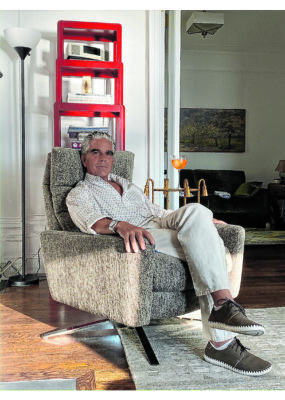Nassau County Museum of Art exhibit focuses on NYC art of the 1980s
On March 23, the Nassau County Museum of Art in Roslyn will open the Urban Art Evolution exhibit, curated by art collector and gallerist Christopher Pusey of Port Washington.

(Photo courtesy Christopher Pusey)
The exhibition will offer artwork from the 1980s to the present by creators based in the downtown area of New York City known as Loisaida/LES (Lower East Side/East Village) and surrounding neighborhoods.
The exhibit’s timing is influenced by the 50th anniversary of the birth of hip-hop music and the 40th anniversary of the documentary on the graffiti art movement Wild Style. Pusey, growing up in an artistic household, received a degree from Stony Brook University focusing on printmaking and he spent a summer in Europe.
“I came back and quickly realized I was better at talking about art than making a living out of creating art,” Pusey said. “I eventually found my way to SoHo in the 1980s to work in a gallery and I thrived in that environment.”
As a young art dealer, Pusey said he witnessed a creative shift.
“That part of the city was very affordable, it was very hard-scrabble,” Pusey said. “It was a neighborhood that had completely fallen into chaos on many levels. There were abandoned buildings. The drug trade had a firm foothold, if you would, in the East Village, in the Lower East Side.”
Because the neighborhood was affordable, artists could have larger spaces with relatively affordable overhead.
“I found myself drawn to this creativity that was coming out of there,” Pusey said. “Everything we were dealing with in the ‘80s, in the gallery I was working with in SoHo, we kept looking east for what was next, what was new, what was fresh, what was controversial.”
Jean-Michel Basquiat and Keith Haring were among the artists who emerged from the “[Andy] Warhol-tutelage,” as Pusey put it.
And it wasn’t just pop art; it was also performance art, photography, theater and other mediums that made up the “cauldron of creativity” in the East Village.
In the 1990s, Pusey pivoted from the resale gallery business to become a private dealer and advisor. But Pusey would return to the “art world,” in 2010 opening his own gallery Dorian Gray Projects in the East Village.
“When I was in the East Village, I had a lot of time to reconnect with the artists that were part of the fabric of East Village, the downtown art scene,” Pusey said. “This is a decade and a half later after the peak of the East Village, but a lot of artists were still there working and doing their business and their craft and their creativity.”
The gallery displayed the work of these artists until it closed in 2017, and Pusey held summer pop-ups in the Hamptons and participated in art fairs. In 2017, he partnered with an investor and art collector to operate the Chase Contemporary gallery in Chelsea, and he moved to a 10,000 square foot space in SoHo after the pandemic.
Over time, Pusey gained a reputation as an art dealer and collector with a niche in art from the 1980s, particularly graffiti art.
Pusey was approached by Nassau County Museum of Art board members, asking what he would curate if he could curate a museum installation.
“I went with what I know, which is urban art and art from the downtown art scene,” Pusey said.
Preparing this show was an education, as museum shows typically take years to arrange. Though a challenge with the quick turnaround, he was able to pull together 135 pieces for the Urban Art Evolution exhibition from over 35 artists and artist estates through the connections and relationships he built throughout his career.
“With its roots in street graffiti, Urban Art Evolution encompasses the progression of works through this period that began furtively on exterior surfaces, then moved inside city apartments and art studios, then into exhibition contexts in galleries and museums, and back outside as commissions for public spaces – this fascinating and rarely-told story is at the heart of NCMA’s next exhibition,” said Beth Horn, the executive director of the Nassau County Museum of Art.



















